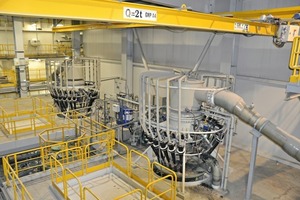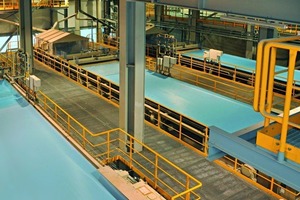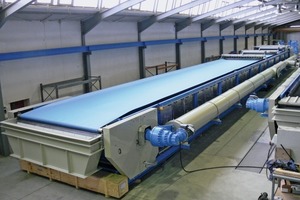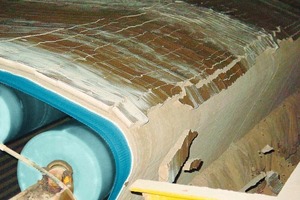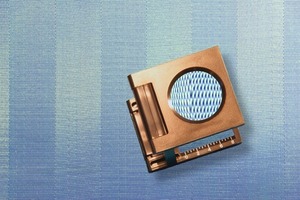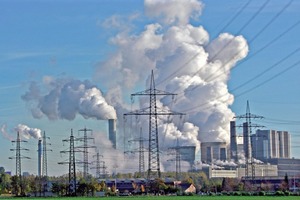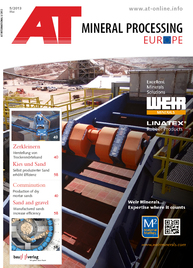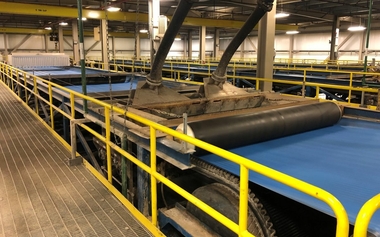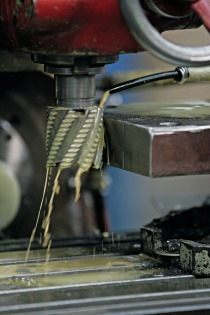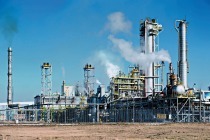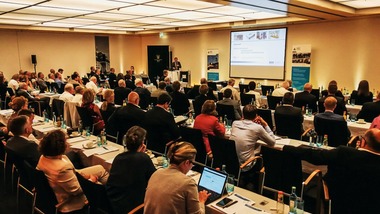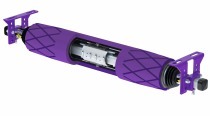FGD gypsum dewatering – the new generation
The future belongs to renewable energies. Experts agree notwithstanding that up to the year 2030 non-renewable energies will have 75 % of the energy mix worldwide. After petroleum coal is in this context the world’s most important fossil energy source. In the year 2010 it covered 30 % of global primary energy consumption1, in Germany just under 40 % of domestic power generation. In 2009 every fourth kilowatt hour of power consumed in Germany came from brown coal2. Domestic mineral coal production is on the decrease due to the expiration of subsidies in 2018. By contrast, significantly more mineral coal than brown coal is being produced globally. The flue gas formed by every coal burn is being scrubbed in an ecologically responsible way in flue gas desulphurisation plants (FGDP) inter alia. FGD gypsum emerges as a byproduct of this process – about 7 million tonnes annually worldwide3. This base material is required in the construction and cement industry in very large quantities, e.g. in the manufacture of drywall. For FGD gypsum dewatering in vacuum belt filter systems the largest coal power stations in the world rely on filter belts of the VACUBELT type from GKD – Gebr. Kufferath AG. Virtually every well-known plant manufacturer relies on the efficiency of these innovative filter cloths too.
In the year 2007, 5.5 Gt (= 5.5 billion tonnes) of hard coal (hard brown coal, mineral coal, anthracite coal) and 0.98 Gt of soft brown coal were produced across the world. China is the country that produces the most hard coal (2.5 Gt), followed by the USA (0.97 Gt), India (0.45 Gt), Australia (0.32 Gt) and South Africa (0.24 Gt)4. Parallel to the constantly increasing production volumes, newly constructed power stations, station expansions and renovations are booming. It is the goal of these activities to increase the efficiency of the conversion of coal into electricity and to continue to decrease emissions through improved technologies for dedusting, denitrifying and desulphurising flue gases. One of these power stations of the future is presently unfolding in Neurath in the form of two new brown coal power station blocks. Each of these power station blocks has a gross output of 1100 megawatts and an efficiency factor of more than 43 %. Its optimised plant technology is basically in line with the concept of the blocks already in place but takes much better advantage of the fuel used. As a result, they increase their efficiency by about 31 % compared with the hitherto existing plants. Consequently, they greatly decrease gas and dust emissions as well. In this way, in the flue gas desulphurisation plant, for instance, more than 90 % of the sulphur dioxide is separated and transformed into gypsum slurry. The subsequently condensed, 60–65 degrees Celsius hot gypsum suspension is dewatered in vacuum belt filters in a continuous process. This operation imposes tough demands on the mechanical, thermal and chemical capacity of the filter belt used.
The core of the system for FGD gypsum dewatering in the new brown coal blocks with optimised plant technology in Neurath consists of two 35 metre long and 3.50 metre wide vacuum belt filter installations from the international plant manufacturer FLSmidth. With a total filter surface area of 93 m2 each they are counted among the largest FGD belt filters in the world. For many years now FLSmidth has been relying on FGD gypsum filter cloths in VACUBELT belts from GKD. This is why in 2008 the two new blocks in Neurath were specifically equipped with the double-layered VACUBELT 2025 filter belt. In this case, a twilled two-ply mesh made of polyester monofilaments with staple fibres is involved, whose reliability and efficiency Thomas Triebert, Senior Sales Manager Power/FGD, had already learned to appreciate at several other power stations. Still in the installation phase, however, as one of the belts at Neurath became damaged due to an accident in the plant, he selected the new VACUBELT 2015 belt type made entirely of polyester monofilaments as a replacement. When GKD was presenting the VACUBELT 2015 at the ACHEMA 2009, he was one of the first plant manufacturers to put the innovative technology to use, in a power station project at Tušimice in the Czech Republic. The unique mesh design with more pores per square metre with a smaller opening at the same time proved itself to be especially efficient even during this initial application. With greater air permeability, faster dewatering and the fact that the mesh did not block up and was easier to clean, the VACUBELT 2015 outperformed the performance of conventional belts by far. This is why for Thomas Triebert the installation of this type of belt as a replacement at Neurath too was obvious. The test run of the systems began in 2011. There the gypsum suspension with 15 % solids content is condensed in hydrocyclones and then with a solid content of 50 to 60 % spread on the giant vacuum belt filters. The belt filters extract moisture at more than 90 % from 81 tonnes of gypsum an hour – and doing so operating non-stop. The filtrate purity realised is under 0.5 % with dry matter of 8 %. An efficiency which Thomas Triebert confirms in his estimation that the all-monofilament VACUBELT 2015 has set new, groundbreaking standards for vacuum filter belts.
An assessment that Detlev Stronczek, Head of Sales Power Plant-Processing at ThyssenKrupp Fördertechnik (TKF), also shares. Consequently, he too has been using this belt type in various vacuum belt filters for FGD gypsum dewatering since 2009 already: in the Rheinhafen-Dampfkraftwerk Karlsruhe, Datteln 4 and Maasvlakte (Netherlands) mineral coal power stations and in the Belchatov (Poland), Turcini (Romania) and Maritza II (Bulgaria) brown coal power stations.
Good reason for him to consider using this kind of belt at the Belchatov power station, for instance. With 12 blocks, this largest brown coal power station in the world supplies a total output of 4400 megawatts of electricity. ThyssenKrupp Fördertechnik had already equipped six of the blocks in years past, of them four with complete belt filter systems and two with hydrocyclones. So it was not surprising that TKF was commissioned with equipping the 13th block which is to produce another 850 megawatts of electricity. Three vacuum belt filters with 55 m2 of filter surface area each were installed here in 2011. TKF equipped all three with VACUBELT filter belts. The 2015 belt type impressed Detlev Stronczek immediately for several reasons: In addition to the high air flow rate and the dewatering effect optimised as a result, the polyester monofilament’s thermal resistance is particularly significant. He cites the cross-stability and smooth belt surface as another advantage, whereby the belt can be easily cleaned by spray pipes in the integrated cleaning unit. Moreover, the smooth surface texture reduces the possibility of confusion because the cloth can be applied from either side. Thanks to its extreme mechanical sturdiness the VACUBELT 2015 can be adjusted to a speed of operation in line with demand. An advantage that proves its worth with major flexibility in throughput times and nominal thickness as regards non-contract specific feeding quality for gypsum suspension in particular. Immediately the continuous density measurement detects aberrant solid matter concentrations in the flue gas scrubber, the system will automatically run faster or slower in order to achieve unalteredly good results. The spreader vanes typical of TKF systems in suspension feeding also ensure uniform spreading of the gypsum suspension and unvarying dewatering efficiency even at different speeds. Belt filters equipped with VACUBELT 2015 belts reduce residual gypsum moisture permanently to under 10 % and at Belchatov produce 45 tonnes of drier per unit per hour.
With the exceptional efficiency of its VACUBELT 2015, GKD was able to convince a considerable number of power stations in other leading coal producing countries too. In the USA more than 15 power stations with an output volume between 1 to 2.7 gigawatts are equipped with over 35 VACUBELT belts on average every year. The all-monofilament VACUBELT 2015 in the most common belt size there is 50 metres long and 3 metres wide and is an overwhelming favourite at the American coal power stations. But the two-ply belt types of the successful filter belt family are being used in the USA as well: The VACUBELT 2025 with staple fibres and the VACUBELT 2035 with multifilament weft wires are still sought-after solutions in America. In South Africa another top power station relies on GKD’s innovative belt technology: The Kusile mineral coal power station (still under construction), located there at 100 kilometres east of Johannesburg, was equipped with high-performance VACUBELT 2015 belts in 2011. With 4800 megawatts of rated output, Kusile is ranked among the largest coal power stations in the world.

